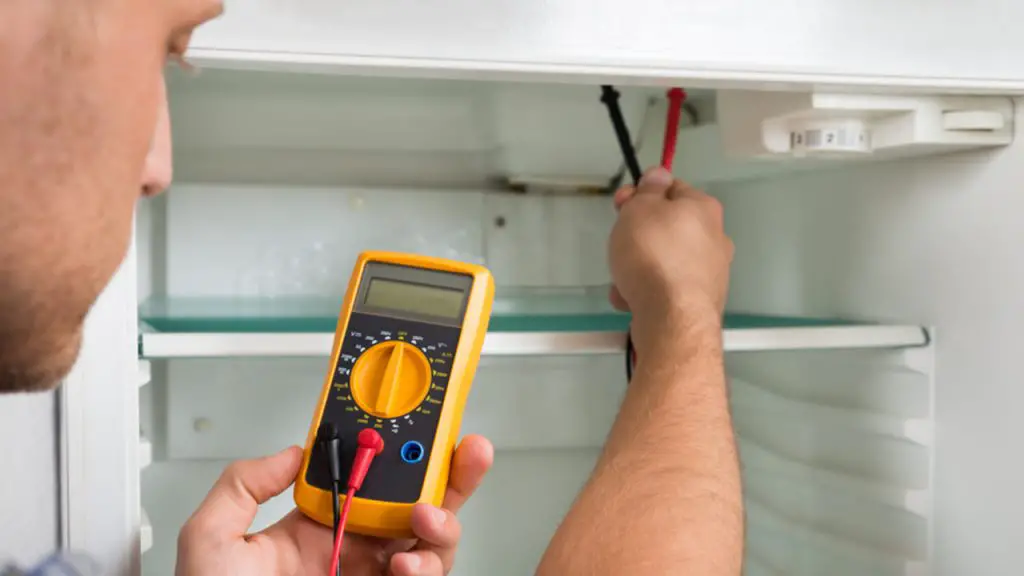When it comes to “how many amps does a refrigerator use”, there is a lot of information to take in. It can be confusing trying to figure out how much energy your fridge consumes and how you can go about reducing that number.
In this article, we will break it all down for you.

We’ll start by discussing how to calculate the amount of energy your fridge uses. Then we’ll talk about how many amps you need to support your fridge and what you can do if you don’t have enough amperage available.
Finally, we’ll give you some tips on how to save energy when using your refrigerator.
The amperage of any refrigerator is determined by its size. Larger refrigerators can chill more, but they also require larger compressors.
The compressor is the biggest power consumer in a refrigerator. In addition to the compressor, the light bulb is another electricity user in a refrigerator.
A 40-watt incandescent light bulb is used, which is a typical amount. It doesn’t contribute much to the variation because it’s always a regular 40 watts.
The average electrical rating of a modern household refrigerator is 3 to 6 amps, whereas the range varies from 1 to 15 amps depending on the size and power requirements of the compressor.
Methods to Calculate Energy Usage
The refrigerator may be one of the most power-consuming appliances in your home-particularly if it’s an older model.
“How many amps does the refrigerator use” over time is a question to which there are several answers.
1. Energy Star Rating
The most straightforward approach is to check the energy consumption on your refrigerator’s model number and see if it has an Energy Star Rating. If it does, the predicted yearly electricity consumption would’ve been provided.
Let’s take an example.
Energy consumption: 230 kWh per year i.e., 230,000 Watt-hours per year
To get watt-hours per day, you’ll have to divide 230,000 by 365 i.e, the number of days in a year which will be around 630.13 wh:
230,000 / 365 = 630.13 wh
If you divide 630.13 watt-hours by the number of hours in a day (24) you get 26.25 average running watts:
To get average running watts, you’ll have to divide 630.13 by 24 i.e, the number of hours in a day which will be around 26.25:
630.13 / 24 = 26.25
If you divide the running watts by the voltage, you will get amps (Watts/Volts = Amps). Most refrigerators in North America run on 120 volts since this is the common standard. If you take the 26.25 average watts and divide it by 120 volts, you’ll find that the fridge consumes one average of .218 amps:
26.25 / 120 = .218
2. Energy Meter
Considering that your refrigerator does not have an energy star rating, you’ll have to reach out to the manufacturer of the fridge or get an energy meter or KWH meter.
The reason your fridge may not have a rating is that it’s commercial. This device will help you calculate how much power your fridge consumes. It’s a quick and accurate way to measure power consumption.
User instructions are usually included with your meter, but they’re typically quite simple to understand. This gadget works by connecting the meter to the wall outlet and then the refrigerator to it.
The device’s power consumption will be recorded over time using the meter.
These meters are usually low-cost, and using one may potentially save you money on your power bill by informing you about how much energy your appliances consume.
3. Nameplate Amperage
Another approach is to use the nameplate amperage to perform a calculation. Depending on the anticipated duty cycle, the end result of a calculation based on the refrigerator nameplate amperage rating is more or less an informed guess.
What is a duty cycle, and how is it different from a compressor’s running time? A refrigerator compressor does not operate continuously. Instead, it cycles on and off.
The percentage of time the compressor is operating is known as the duty cycle. The average amperage will be lower than the nameplate value owing to the duty cycle.
For instance: Suppose an electric appliance has a nameplate amperage of 4 amps and a duty cycle of 35 percent then, the average running amperage will be 1.4 amps.
How Many Amps are Needed to Support a Fridge?
If we assume that watts usage per amp equals 15 to 20 watts, then the average electricity consumption for a refrigerator is 750-1000 watts.
The fridge consumes 10% of the overall electricity consumed in a home. It is also important to use the formula, amps = watts/voltage when calculating the average amps required to power a refrigerator.
Residential users will generally be supplied with a 120-volt supply.
How Many Amps are Needed for a Mini-Fridge?
The average amps calculation is simpler to perform by dividing the refrigerator’s consumption by the voltage that will be supplied.
The consumption of electricity is significantly lower in the event of a mini-fridge than in the case of a regular refrigerator. It also cuts down on the amount of electricity used over time.
Because the mini-fridge consumes 240 watts on a voltage of 120 volts, it uses almost 2 amps on average. The average usage of a tiny fridge is 2 amp, making it perfect for offices, flats, and other places where space might be limited.
Need for a Dedicated Circuit
It is generally advised that a separate circuit be set aside for the freezer and refrigerator. It aids in the conduct of best practices and enhances efficiency.
It protects you from harm in the event of a power fluctuation that is due to a change in supply. It’s critical to be prepared for the worst-case scenario in both the freezer and refrigerator cases.
So, if your freezer or refrigerator draws 15-20 amps, use a circuit of 120 volts to protect yourself against voltage/amps fluctuations.
Powering Fridge with a Generator
The fridge may be run over the generator without any issues. However, it’s important to guarantee that there is enough voltage available to power it. So, connect a generator with a capacity of enough watts to operate appliances securely.
To complete the installation, simply attach the generator to your refrigerator with the matching cable.
To avoid the extension cords connections, you may use the portable generator and place it near to or on top of your fridge. After connecting a generator to a fridge via its cord, start both devices simultaneously.
Tips to Save Energy
There are various methods to decrease electricity bills that you may utilize while managing a household. According to Energy Star, certified refrigerators use 20% less energy than standard models.
However, if money is an issue then, there are some free options available as well.
1. Clean it Regularly
Do yourself a favor and add “cleaning of the refrigerator” to your to-do list. Remove and wash the kick plate on the front of the fridge and pull it away from the wall so that you may dust below it as well as the coils on its back.
Its ability to breathe easier will require less energy to run, which means it will require less energy to operate.
2. Place it Away From the Heat
The ideal location for your refrigerator is a cool place away from any heat sources, such as large windows that receive a lot of sunlight.
Refrigerators are doing their work of releasing heat and in such circumstances, putting them in a heated area would be problematic.
3. Set the Right Temperature.
It’s a simple solution to waste energy by having a refrigerator or freezer set at an extremely chilly temperature. Check that the internal thermostats on the fridge and freezer are set to 37°F and 0°F, respectively. These are optimal temperatures and will help you save energy.
4. Cool Food Only, and Lots of It.
To save your compressor from straining, take the time to chill down any hot leftovers before putting them in the fridge. Only room temperature or cold food should be placed in your refrigerator.
Also, make sure that your freezer is three-quarters full so it doesn’t have to work hard to cool down empty space.
5. Move with Speed
Another approach to breaking bad energy-wasting habits is to keep the refrigerator door shut. When you leave the fridge door open, the compressor kicks in and increases the number of watts consumed by the refrigerator.
Try your hardest to take what you want from the fridge and close the door as soon as possible.
Conclusion
In the end, we conclude that it all depends on the size and model of your fridge when answering “how many amps does a refrigerator use?”. We also discussed how to measure the power consumption and how you can use a generator to power your refrigerator.
Plus, Modern refrigerators have energy-saving features that can help lower your electricity usage. To save even more, follow the tips on how to save energy.
FAQs
Can I plug two refrigerators into the same outlet?
Yes, you can plug two refrigerators into the same outlet. However, you will need to use a circuit of 120 volts to protect yourself against voltage/amps fluctuations.
Remember not to exceed 2 appliances or there might be severe problems. Additionally, make sure that the fridge is not in a heated area and that you clean it regularly to avoid straining the compressor.
How to calculate amperage?
To calculate amperage, you will need to use a multimeter. Simply set the multimeter to the “amps” setting and touch the probes to the positive and negative terminals on your refrigerator. This will give you a reading of how many amps your refrigerator is using.
You can also use this method to calculate how many watts your refrigerator is using. Simply multiply the number of amps by the voltage (120 volts for North America). This will give you a wattage reading.
How much power does a mini fridge use?
A mini-fridge uses about 140-240 watts of power, which is about 0.84-2 amps. This means that a mini-fridge would use about 20% less energy than a standard fridge.
Do I need a dedicated circuit for my refrigerator?
Yes, you should have a dedicated circuit for your refrigerator. This is because refrigerators can use a lot of power and can cause voltage/amps fluctuations if they are on the same circuit as other appliances.
A dedicated circuit will protect your refrigerator from these fluctuations and will also help to prolong its lifespan.
Additional Contents



